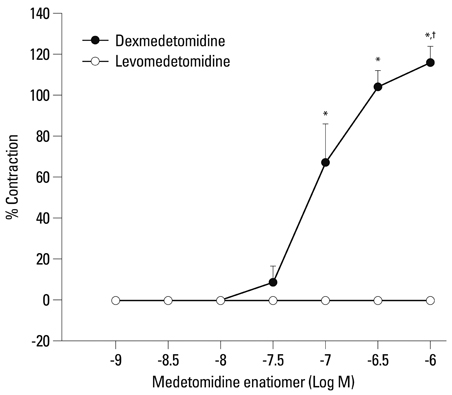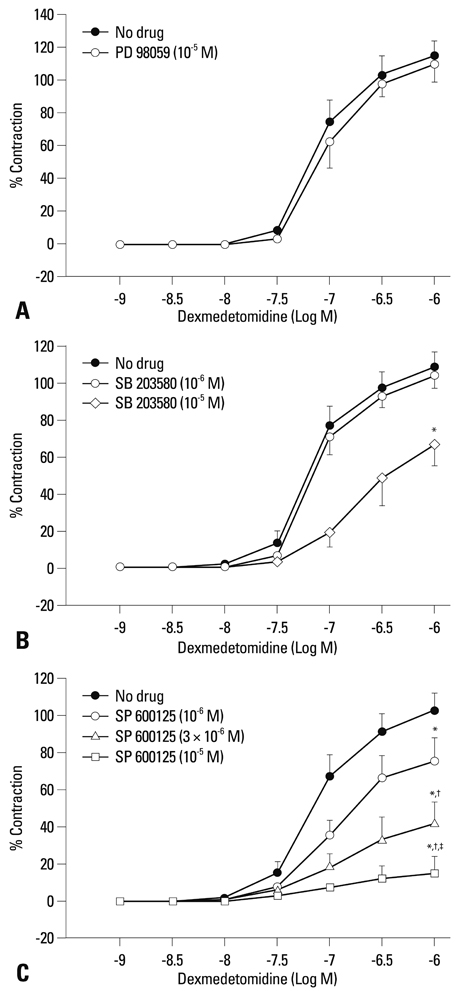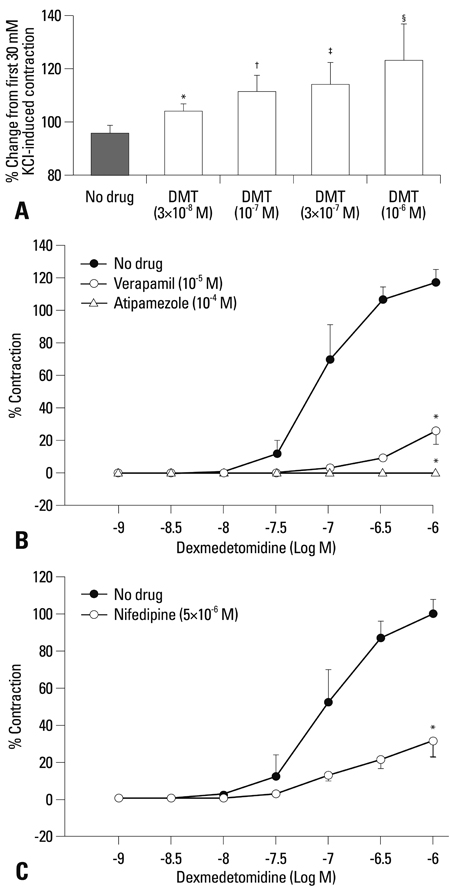Yonsei Med J.
2011 May;52(3):420-428. 10.3349/ymj.2011.52.3.420.
C-Jun NH2-Terminal Kinase Contributes to Dexmedetomidine-Induced Contraction in Isolated Rat Aortic Smooth Muscle
- Affiliations
-
- 1Department of Anesthesiology and Pain Medicine, Gyeongsang National University Hospital, Jinju, Korea.
- 2Department of Anesthesiology and Pain Medicine, Gyeongsang National University School of Medicine, Jinju, Korea. jtsohn@nongae.gsnu.ac.kr
- 3Institute of Health Sciences, Gyeongsang National University School of Medicine, Jinju, Korea.
- 4Department of Pharmacology, Gyeongsang National University School of Medicine, Jinju, Korea.
- 5Department of Physiology, Kwandong University College of Medicine, Kangneung, Korea.
- KMID: 1777013
- DOI: http://doi.org/10.3349/ymj.2011.52.3.420
Abstract
- PURPOSE
Dexmedetomidine, a full agonist of alpha2B-adrenoceptors, is used for analgesia and sedation in the intensive care units. Dexmedetomidine produces an initial transient hypertension due to the activation of post-junctional alpha2B-adrenoceptors on vascular smooth muscle cells (SMCs). The aims of this in vitro study were to identify mitogen-activated protein kinase (MAPK) isoforms that are primarily involved in full, alpha2B-adrenoceptor agonist, dexmedetomidine-induced contraction of isolated rat aortic SMCs.
MATERIALS AND METHODS
Rat thoracic aortic rings without endothelium were isolated and suspended for isometric tension recording. Cumulative dexmedetomidine (10(-9) to 10(-6) M) dose-response curves were generated in the presence or absence of extracellular signal-regulated kinase (ERK) inhibitor PD 98059, p38 MAPK inhibitor SB 203580, c-Jun NH2-terminal kinase (JNK) inhibitor SP 600125, L-type calcium channel blocker (verapamil and nifedipine), and alpha2-adrenoceptor inhibitor atipamezole. Dexmedetomidine-induced phosphorylation of ERK, JNK, and p38 MAPK in rat aortic SMCs was detected using Western blotting.
RESULTS
SP 600125 (10(-6) to 10(-5) M) attenuated dexmedetomidine-evoked contraction in a concentration-dependent manner, whereas PD 98059 had no effect on dexmedetomidine-induced contraction. SB 203580 (10(-5) M) attenuated dexmedetomidine-induced contraction. Dexmedetomidine-evoked contractions were both abolished by atipamezole and attenuated by verapamil and nifedipine. Dexmedetomidine induced phosphorylation of JNK and p38 MAPK in rat aortic SMCs, but did not induce phosphorylation of ERK.
CONCLUSION
Dexmedetomidine-induced contraction involves a JNK- and p38 MAPK-mediated pathway downstream of alpha2-adrenoceptor stimulation in rat aortic SMCs. In addition, dexmedetomidine-induced contractions are primarily dependent on calcium influx via L-type calcium channels.
Keyword
MeSH Terms
-
Adrenergic alpha-2 Receptor Agonists/*pharmacology
Animals
Anthracenes/pharmacology
Aorta/cytology
Dexmedetomidine/*pharmacology
Enzyme Inhibitors/pharmacology
Extracellular Signal-Regulated MAP Kinases/antagonists & inhibitors/physiology
Flavonoids/pharmacology
Imidazoles/pharmacology
JNK Mitogen-Activated Protein Kinases/antagonists & inhibitors/*physiology
Male
*Muscle Contraction
Muscle, Smooth, Vascular/drug effects/enzymology/*physiology
Protein Isoforms/antagonists & inhibitors/physiology
Pyridines/pharmacology
Rats
Rats, Sprague-Dawley
p38 Mitogen-Activated Protein Kinases/antagonists & inhibitors/physiology
Figure
Reference
-
1. Virtanen R, Savola JM, Saano V, Nyman L. Characterization of the selectivity, specificity and potency of medetomidine as an alpha 2-adrenoceptor agonist. Eur J Pharmacol. 1988. 150:9–14.
Article2. Peltonen JM, Pihlavisto M, Scheinin M. Subtype-specific stimulation of [35S]GTPgammaS binding by recombinant alpha 2-adrenoceptors. Eur J Pharmacol. 1998. 355:275–279.
Article3. Schmeling WT, Kampine JP, Roerig DL, Warltier DC. The effects of the stereoisomers of the alpha 2-adrenergic agonist medetomidine on systemic and coronary hemodynamics in conscious dogs. Anesthesiology. 1991. 75:499–511.
Article4. Bloor BC, Ward DS, Belleville JP, Maze M. Effects of intravenous dexmedetomidine in humans. II. Hemodynamic changes. Anesthesiology. 1992. 77:1134–1142.5. Hall JE, Uhrich TD, Barney JA, Arain SR, Ebert TJ. Sedative, amnestic, and analgesic properties of small-dose dexmedetomidine infusions. Anesth Analg. 2000. 90:699–705.
Article6. Lawrence CJ, Prinzen FW, de Lange S. Hemodynamic and coronary vascular effects of dexmedetomidine in the anesthetized goat. Acta Anaesthesiol Scand. 1997. 41:830–836.
Article7. Jalonen J, Halkola L, Kuttila K, Perttilä J, Rajalin A, Savunen T, et al. Effects of dexmedetomidine on coronary hemodynamics and myocardial oxygen balance. J cardiothorac Vasc Anesth. 1995. 9:519–524.
Article8. Flacke WE, Flacke JW, Bloor BC, Mclntee DF, Sagan M. Effects of dexmedetomidine on systemic and coronary hemodynamics in the anesthetized dog. J Cardiothorac Vasc Anesth. 1993. 7:41–49.
Article9. Guimaräes S, Moura D. Vascular adrenoceptors: an update. Pharmacol Rev. 2001. 53:319–356.10. Mizobe T. [Adrenergic receptor and knockout mouse: 2). Alpha adrenergic receptor knockout mouse]. Masui. 2001. 50:12–19.11. Akata T. General anesthetics and vascular smooth muscle: direct actions of general anesthetics on cellular mechanisms regulating vascular tone. Anesthesiology. 2007. 106:365–391.12. Abdel-Latif AA. Cross talk between cyclic nucleotides and polyphosphoinositide hydrolysis, protein kinases, and contraction in smooth muscle. Exp Biol Med (Maywood). 2001. 226:153–163.
Article13. Khan TA, Bianchi C, Ruel M, Voisine P, Sellke FW. Mitogen-activated protein kinase pathways and cardiac surgery. J Thorac Cardiovasc Surg. 2004. 127:806–811.
Article14. Kim B, Kim J, Bae YM, Cho SI, Kwon SC, Jung JY, et al. p38 mitogen-activated protein kinase contributes to the diminished aortic contraction by endothelin-1 in DOCA-salt hypertensive rats. Hypertension. 2004. 43:1086–1091.
Article15. Lee YR, Lee CK, Park HJ, Kim H, Kim J, Kim J, et al. C-Jun N-terminal kinase contributes to norepinephrine-induced contraction through phosphorylation of caldesmon in rat aortic smooth muscle. J Pharmacol Sci. 2006. 100:119–125.
Article16. Carter RW, Kanagy NL. Tyrosine kinases regulate intracellular calcium during alpha (2)-adrenergic contraction in rat aorta. Am J Physiol Heart Circ Physiol. 2002. 283:H1673–H1680.17. Roberts RE. Role of the extracellular signal-regulated kinase (Erk) signal transduction cascade in alpha (2) adrenoceptor-mediated vasoconstriction in porcine palmar lateral vein. Br J Pharmacol. 2001. 133:859–866.
Article18. Choi YS, Jeong YS, Ok SH, Shin IW, Lee SH, Park JY, et al. The direct effect of levobupivacaine in isolated rat aorta involves lipoxygenase pathway activation and endothelial nitric oxide release. Anesth Analg. 2010. 110:341–349.
Article19. Sung HJ, Sohn JT, Park JY, Hwang EM, Baik JS, Ogawa K. Direct effect of ropivacaine involves lipoxygenase pathway activation in rat aortic smooth muscle. Can J Anaesth. 2009. 56:298–306.
Article20. Klegeris A, Giasson BI, Zhang H, Maguire J, Pelech S, McGeer PL. Alpha-synuclein and its disease-causing mutants induce ICAM-1 and IL-6 in human astrocytes and astrocytoma cells. FASEB J. 2006. 20:2000–2008.
Article21. Park MK, Kang YJ, Lee HS, Kim HJ, Seo HG, Lee JH, et al. The obligatory role of COX-2 expression for induction of HO-1 in ischemic preconditioned rat brain. Biochem Biophys Res Commun. 2008. 377:1191–1194.
Article22. Kwak KH. Emergence agitation/delirium: we still don't know. Korean J Anesthesiol. 2010. 59:73–74.
Article23. Dessy C, Kim I, Sougnez CL, Laporte R, Morgan KG. A role for MAP kinase in differentiated smooth muscle contraction evoked by alpha-adrenoceptor stimulation. Am J Physiol. 1998. 275:C1081–C1086.24. Touyz RM, EI Mabrouk M, He G, Wu XH, Schiffrin EL. Mitogen-activated protein/extracellular signal-regulated kinase inhibition attenuates angiotensin II-mediated signaling and contraction in spontaneously hypertensive rat vascular smooth muscle cells. Circ Res. 1999. 84:505–515.
Article25. Watts SW, Yang P, Banes AK, Baez M. Activation of Erk mitogen-activated protein kinase proteins by vascular serotonin receptors. J Cardiovasc Pharmacol. 2001. 38:539–551.
Article26. Civantos Calzada B, Aleixandre de Artiñano A. Alpha-adrenoceptor subtypes. Pharmacol Res. 2001. 44:195–208.
Article27. Yildiz O, Ulusoy HB, Seyrek M, Gul H, Yildirim V. Dexmedetomidine produces dual alpha 2-adrenergic agonist and alpha 1-adrenergic antagonist actions on human isolated internal mammary artery. J Cardiothorac Vasc Anesth. 2007. 21:696–700.
Article28. Bain J, Plater L, Elliott M, Shpiro N, Hastie CJ, McLauchlan H, et al. The selectivity of protein kinase inhibitors: a further update. Biochem J. 2007. 408:297–315.
Article29. Molin JC, Bendhack LM. Clonidine induces rat aorta relaxation by nitric oxide-dependent and -independent mechanisms. Vascul Pharmacol. 2004. 42:1–6.
Article30. Hamasaki J, Tsuneyoshi I, Katai R, Hidaka T, Boyle WA, Kanmura Y. Dual alpha (2)-adrenergic agonist and alpha (1)-adrenergic antagonist actions of dexmedetomidine on human isolated endothelium-denuded gastroepiploic arteries. Anesth Analg. 2002. 94:1434–1440.
Article31. Motulsky HJ, Snavely MD, Hughes RJ, Insel PA. Interaction of verapamil and other calcium channel blockers with alpha 1- and alpha 2-adrenergic receptors. Circ Res. 1983. 52:226–231.
Article32. Kim HJ, Sohn JT, Jeong YS, Cho MS, Kim HJ, Chang KC, et al. Direct effect of dexmedetomidine on rat isolated aorta involves endothelial nitric oxide synthesis and activation of the lipoxygenase pathway. Clin Exp Pharmacol Physiol. 2009. 36:406–412.
Article33. Vanhoutte PM. Calcium-entry blockers, vascular smooth muscle and systemic hypertension. Am J Cardiol. 1985. 55:17B–23B.
Article34. Cussac D, Schaak S, Denis C, Paris H. alpha 2B-adrenergic receptor activates MAPK via a pathway involving arachidonic acid metabolism, matrix metalloproteinases, and epidermal growth factor receptor transactivation. J Biol Chem. 2002. 277:19882–19888.
Article35. Shah S, Sangari T, Qasim M, Martin T. Severe hypertension and bradycardia after dexmedetomidine for radiology sedation in a patient with acute transverse myelitis. Paediatr Anaesth. 2008. 18:681–682.
Article36. Zub D, Berkenbosch JW, Tobias JD. Preliminary experience with oral dexmedetomidine for procedural and anesthetic premedication. Paediatr Anaesth. 2005. 15:932–938.
Article37. Sakurai Y, Obata T, Odaka A, Terui K, Tamura M, Miyao H. Buccal administration of dexmedetomidine as a preanesthetic in children. J Anesth. 2010. 24:49–53.
Article38. Ebert TJ, Hall JE, Barney JA, Uhrich TD, Colinco MD. The effects of increasing plasma concentrations of dexmedetomidine in humans. Anesthesiology. 2000. 93:382–394.
Article39. Joshi MS, Ferguson TB Jr, Johnson FK, Johnson RA, Parthasarathy S, Lancaster JR Jr. Receptor-mediated activation of nitric oxide synthesis by arginine in endothelial cells. Proc Natl Acad Sci U S A. 2007. 104:9982–9987.
Article
- Full Text Links
- Actions
-
Cited
- CITED
-
- Close
- Share
- Similar articles
-
- Dexmedetomidine-induced contraction of isolated rat aorta is dependent on extracellular calcium concentration
- Tyrosine phosphorylation of paxillin may be involved in vascular smooth muscle contraction
- Role of Tyrosine Kinases in 5-HT-Induced Vascular Contraction in Two-Kidney, One Clip Hypertensive Rats
- Regulation of Protein Kinase in KCl-induced Contraction of Cat Gastric Smooth Muscle
- The Effects of Diazepam on the Carbachol Induced Contraction of the Isolated Rat Ileum





